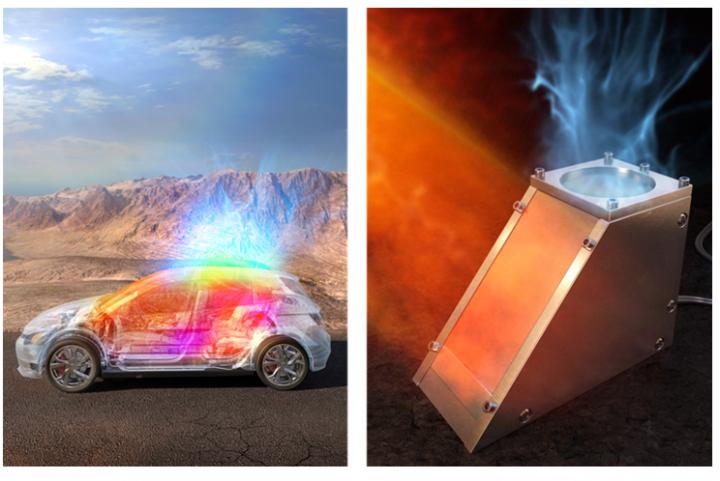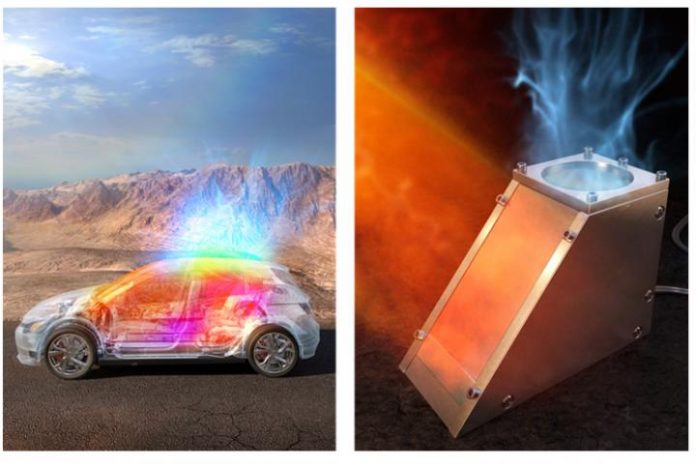
Photo: The bottom layer of the Janus emitter absorbs the heat inside the vehicle and emits it through the top layer to the atmosphere (indicated in blue), causing a temperature drop….
view more
Credit Image: Young Min Song/GIST
If you have ever stepped into a car parked under the sun, you would be familiar with how hot it can get on the inside. This occurs because although sunlight can pass through the transparent windows, the thermal radiation re-emitted by the interior cannot, thereby creating a “greenhouse effect” and heating the inside of the car to temperatures as high as 82°C. Elderly people and children are at a particularly high risk of suffering heatstroke or hyperthermia at such temperatures.
This heat from a parked vehicle can be released by either spending energy in active cooling, which is not sustainable, or opening a window, which is not ideal on rainy days or when driving on a highway. Fortunately, scientists from Gwangju Institute of Science and Technology (GIST), Korea, have developed a new type of passive cooling technology to solve this issue.
In a new study, published in Science Advances, they present a device called “Janus emitter,” or JET. Named after the two-faced Greek god Janus, the JET comprises a stack of patterned quartz, silver, and polydimethylsiloxane thin layers. Each face of the JET has unique properties for passively cooling enclosed spaces. The bottom side absorbs a broad spectrum of thermal radiation from inside the enclosure and, through a quantum phenomenon called “spoof surface plasmon polaritons,” re-emits this energy to the atmosphere on the top side in a selective frequency range that maximizes emissivity. Prof Young Ming Song, who led this study, explains, “The ‘Janus’ thermal radiation characteristics of the JET allow it to function as a heat channel that efficiently draws heat from the enclosure and sends it outside.”
The JET requires no electricity at all and no conscious effort from the user, which makes it a sustainable way of keeping the temperature of stationary vehicles, building interiors, and solar cells low. Excited about the results, Dr Song concludes, “Our work is the first to address passive radiative cooling for enclosed spaces, and we hope it creates a ripple effect that bolsters research in this field.”
Indeed, as this novel technology takes off, staying cool doesn’t have to be so hard anymore!
###
Reference
Authors: Se-Yeon Heo (1), Gil Ju Lee (1), Do Hyeon Kim (1), Yeong Jae Kim (1), Satoshi Ishii (2)(3), Min Seok Kim (1), Tae Joon Seok (1), Bong Jae Lee (4), Heon Lee (5), Young Min Song (1).
Title of original paper: A Janus emitter for passive heat release from enclosures
Journal: Science Advances
DOI: 10.1126/sciadv.abb1906
Affiliations:
(1) School of Electrical Engineering and Computer Science (EECS), Gwangju Institute of Science and Technology
(2) International Center for Materials Nanoarchitectonics, National Institute of Materials Science (NIMS)
(3) Japan Science and Technology Agency, PRESTO
(4) Department of Mechanical Engineering, Korea Advanced Institute of Science and Technology (KAIST)
(5) Department of Materials Science and Engineering, Korea University
About Gwangju Institute of Science and Technology (GIST)
Gwangju Institute of Science and Technology (GIST) is a research-oriented university situated in Gwangju, South Korea. One of the most prestigious schools in South Korea, it was founded in 1993. The university aims to create a strong research environment to spur advancements in science and technology and to promote collaboration between foreign and domestic research programs. With its motto, “A Proud Creator of Future Science and Technology,” the university has consistently received one of the highest university rankings in Korea.
Website: http://www.
About the author
Prof Young Min Song received a PhD in Information and Communications from Gwangju Institute of Science and Technology (GIST), Korea, in 2011. From 2011 to 2013, he was a postdoctoral research associate in the Department of Materials Science and Engineering at the University of Illinois at Urbana-Champaign (UIUC), USA. He is currently serving as an Associate Professor in the School of Electrical Engineering and Computer Science at GIST. His group is developing advanced optoelectronic sensors/systems, multifunctional nanophotonics, flexible devices, optical healthcare systems, and radiative cooling devices/materials. He is also a co-founder of FOEL Inc.
TDnews (tunisiesoir.com)















